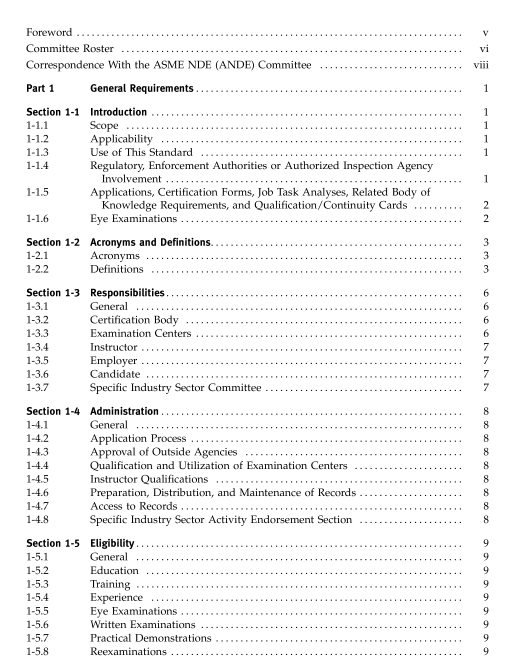ASME ANDE-1 pdf download

ASME ANDE-1 pdf download ASME Nondestructive Examination and Quality Control Central Qualification and Certification Program
1-1.1 SCOPE
(a) This Standard includes both performance-based and prescriptive requirements to be used for an ASME Nondestructive Examination and Quality Control Central Qualification and Certification Program that applies to NDE personnel and QC Inspection personnel.
(b) This Standard uses a SAT process that integrates with JTAs and established Body of Knowledge (BoK) requirements, to provide personnel experience requirements, written examinations, and practical demonstrations.
(c) This Standard is applied by a Third-Party Certification Organization, which is referred to within this Standard as a Certification Body (CB).
(d) The use of the terms Level I, Level II, or Level III in this Standard apply to a CB certified individual.
(e) Specific requirements for industry sectors are included in the Mandatory Appendices of this Standard such as the Nuclear Sector in Mandatory Appendix I.
1-1.2 APPLICABILITY This Standardisapplicable to anyIndustryorIndustry Sector that performs Industry Sector Activities such as Manufacturing, Fabrication, Construction, Installation, Maintenance, Preservice Inspection (PSI), and Inservice Inspection (ISI) that require NDE or QC Inspections to be performed by qualified and certified NDE and QC Inspection personnel.
1 1-1.3 USE OF THIS STANDARD This Standard is required to be used when referenced by a user’s Code, Standard, Specification, Procedure, or Instruction, which the user has committed to meet or is required to meet. Optional use of this Standard is not prohibited, but when this Standard is used, all requirements are mandatory, includingMandatoryAppendices, except where specific alternatives are provided in this Standard. Use of Nonmandatory Appendices is optional, but when they are chosen to be used, all the requirements within a Nonmandatory Appendix becomemandatoryunless the NonmandatoryAppendix is specified for guidance only. See Nonmandatory Appendix A for guidance on maintenance of the Standard.
1-1.4 REGULATORY, ENFORCEMENT AUTHORITIES OR AUTHORIZED INSPECTION AGENCY INVOLVEMENT When a referencing Code, Standard, Specification, Procedure, or Instruction requires the use of this Standard and has requirements that shall be met for the involvement of Regulatory, Enforcement Authorities or an Authorized Inspection Agency (AIA), then those authorities or agencies shall be provided full access with the certified individual’s written approval, to any record of documentation, qualification, or certification activi- ties performed to meet this Standard.
1-1.5 APPLICATIONS, CERTIFICATION FORMS, JOB TASK ANALYSES, RELATED BODY OF KNOWLEDGE REQUIREMENTS, AND QUALIFICATION/CONTINUITY CARDS When required or referenced in this Standard, Application and related Forms, the latest applicable Specific Industry Sector (SIS) Committee approved NDE or QC method and endorsement related JTAs, BoKs, Qualification/Continuity Cards, and their instructions for use shall be used.
1-1.6 EYE EXAMINATIONS
(a) In addition to maintaining certification, candi- dates shall demonstrate satisfactory visual acuity to per- form NDE or QC methods, as applicable. The eye examination shall be given on an annual basis (i.e., certi- fied personnel shall receive and successfully pass vision acuityexaminations atintervals notto exceed 1 yr, which expire on the last day of the month of the expiration date, in order to maintain their certifications in an active status) in accordance with the following requirements:
(1) Near Vision Acuity. Near vision acuity, natural or corrected, of Jaeger 1 or equivalent at a distance of not less than 12 in. (30 cm) or other requirements that may be required by the referencing Code, Standard, Procedure, Specification, or Instruction in at least one eye, shall be demonstrated by the candidate. Testing methods that are capable ofdetermining equivalent (i.e., equivalency is to be determined by a medical profes- sional who performs eye examinations) visual acuity may be used.
(2) Far Vision Acuity. Far vision acuity, natural or corrected, of at least 20/30 (Snellen) at a distance that is required by the referencing Code, Standard, Procedure, Specification, or Instruction in at least one eye, shall be 2 demonstrated by the candidate. Testing methods that are capable of determining equivalent [i.e., equivalency same as in (1) above] visual acuity may be used. (3) Color Differentiation/Contrast. Personnel shall demonstrate the capability to distinguish the colors applicable to the test methods for which certified and to differentiate contrast between these colors. Accepted examination types include H-R-R Pseudoisochromatic, Ishihara, Dvorine, and Farnsworth. Equivalent examina- tions maybe performed whenequivalencybya qualified and licensed medical professional has been determined. Any limitation in color perception shall be evaluated in accordance with the Employer’s Eye Examination Program by a qualified individual. Limitations shall be documented on the candidate’s eye examination documents.
(4) Vision Correction. When, vision correction is necessary to pass the visual acuity examinations, the same vision correction device shall be worn during all testing/inspections. Candidates utilizing multiple correction devices during testing/inspections such as eye lenses and contact lenses shall complete a visual acuity examination for each correction device.









